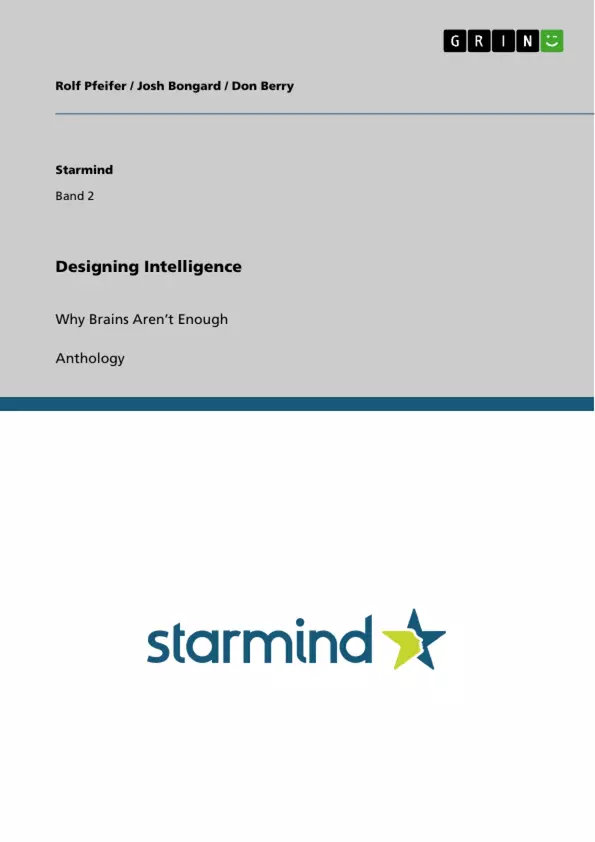This is a book about embodiment -- the idea that intelligence requires a body -- and how having a body shapes the way we think. The idea that the body is required for intelligence has been around since nearly three decades ago, but an awful lot has changed since then. Research labs and leading technology companies around the world have produced a host of sometimes science fiction-like creations: unbelievably realistic humanoids, robot musicians, wearable technology, robots controlled by biological brains, robots that can walk without a brain, real-life cyborgs, robots in homes for the elderly, robots that literally put themselves together, and artificial cells grown automatically. This new breed of technology is the direct result of the embodied approach to intelligence. Along the way, many of the initially vague ideas have been elaborated and the arguments sharpened, and are beginning to form into a coherent structure. This popular science book, aimed at a broad audience, provides a clear and up to date overview of the progress being made. At the heart of the book are a set of abstract design principles that can be applied in designing intelligent systems of any kind: in short, a theory of intelligence. But science and technology are no longer isolated fields: they closely interact with the corporate, political, and social aspects of our society -- so this book not only provides a novel perspective on artificial intelligence, but also aims to change how we view ourselves and the world around us.
Credits:
Front Cover Design by Hakam El Essawy
Featuring the humanoid robot ‘EDS’
Photo: Patrick Knab
Robot construction: The Robot Studio (TRS)
ECCE Robot project: EU's 7th Framework Programme, ICT Challenge2,
'Cognitive Systems and Robotics'
Motors: maxon motor, Switzerland
Know-How Partner: Starmind.com
Inhaltsverzeichnis (Table of Contents)
- Preface
- 1. Intelligence, Thinking and Cognition
- In this chapter we will introduce the concepts intelligence, thinking and cognition, discuss why intelligence has fascinated people from all walks of life throughout history, and introduce the field of artificial intelligence.
- 2 Prerequisites for a Theory of Intelligence
- Chapter 3 outlines what type of theory we are looking for and introduces a number of important notions such as diversity-compliance, frames of reference, the synthetic methodology, time perspectives, emergence, and real world agents.
- 3 The Design Principles
- In this chapter we sketch a set of design heuristics what we call the design principles for intelligent systems that can be used to guide us in building new agents and understanding biological ones.
- 4. Development: From Locomotion to Cognition
- This chapter explores design and analysis issues from a developmental perspective, and asks how high-level cognition can emerge as an agent matures.
- 5. Evolution: Cognition from Scratch
- Chapter 6 looks at how we can harness ideas from biological evolution in order to design agents from scratch.
- 6. Collective Intelligence
- This chapter discusses phenomena that come about when agents interact in groups.
- 7. Ubiquitous computing and Everyday Robotics
- In this chapter we discuss ubiquitous computing, a rapidly expanding discipline where the goal is to 'put computers everywhere', as well as exploring the development of robots that could enter into and participate in our everyday lives.
- 8. Where is Human Memory?
- Chapter 9 presents a case study on human memory that illustrates how embodiment provides a new perspective on challenging research problems old and new.
- 9. Building Intelligent Companies
- This chapter, written with management expert Simon Grand, applies the perspective of embodied intelligence to the business world, and in particular to the design and construction of new products, businesses.
- 10. Conclusion: Principles and Insights
- Lastly we will summarize the main points of our theory, and present a collection of examples illustrating how things can always be seen differently.
Zielsetzung und Themenschwerpunkte (Objectives and Key Themes)
This book aims to develop a comprehensive theory of intelligence, challenging traditional assumptions and exploring the role of embodied cognition and the design principles of intelligent systems.
- Embodied Cognition: How physical embodiment and interaction with the environment shape intelligence.
- Design Principles for Intelligent Systems: Identifying key heuristics for building intelligent agents.
- Developmental and Evolutionary Perspectives: Exploring how intelligence emerges through development and evolution.
- Collective Intelligence: Examining the nature of intelligence in groups of agents.
- Applications in Robotics and Business: Applying the principles of embodied intelligence to real-world applications.
Zusammenfassung der Kapitel (Chapter Summaries)
The book begins by introducing the concepts of intelligence, thinking, and cognition, discussing the historical fascination with intelligence and introducing the field of artificial intelligence. It then outlines the authors' vision for a theory of intelligence, emphasizing the importance of embodied cognition, diversity-compliance, frames of reference, the synthetic methodology, and real-world agents. The authors then present a set of design principles for intelligent systems, drawing inspiration from biological systems. The book explores the development of intelligence from a developmental perspective, examining how high-level cognition can emerge as an agent matures. It also investigates the role of evolutionary processes in designing intelligent agents from scratch.
The authors then delve into the concept of collective intelligence, analyzing the phenomena that arise when agents interact in groups. They discuss the rapidly growing field of ubiquitous computing, exploring the development of robots that can participate in our daily lives. The book further examines the embodiment of human memory, showcasing how embodiment can provide new perspectives on challenging research problems. Finally, it explores the application of embodied intelligence to the business world, highlighting its potential for designing and building new products and businesses.
Schlüsselwörter (Keywords)
The book focuses on key terms and concepts such as embodied cognition, design principles, artificial intelligence, developmental robotics, evolution, collective intelligence, ubiquitous computing, human memory, and business intelligence.
- Citar trabajo
- Rolf Pfeifer (Autor), Josh Bongard (Autor), Don Berry (Autor), 2011, Designing Intelligence, Múnich, GRIN Verlag, https://www.grin.com/document/165548



